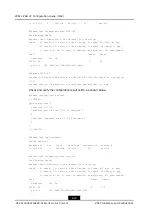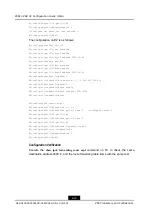
Chapter 7
IS-ISv6 Configuration
Table of Contents
7.1 IS-ISv6 Overview
The Intermediate System-to-Intermediate System (
) protocol is a routing protocol
developed by the International Organization for Standardization (
) for CLNS. It is a
network layer protocol of the OSI protocol suite. It has been expanded to support IP
routing and form an integrated IS-IS protocol. The IS-IS protocol currently mentioned
refers to the integrated IS-IS protocol.
The IS-IS protocol is used as an Interior Gateway Protocol (
) in plenty of networks.
Its operating mechanism is similar to that of the OSPF protocol. It divides a network into
multiple areas. The routers in an area can manage only the routing information in the area.
This saves router costs and thus makes it suitable for large- and medium-scale networks.
The IS-IS protocol also uses Dijkstra's SPF algorithm to compute routes. It uses the SPF
algorithm to obtain the optimal route according to the link status database and then adds
the route to the IP routing table.
IS-IS is a routing protocol with high expansibility, so it can support the expansion of the
CLNS routing protocol to support IPv4 and support IPv6.
Uni-topology IS-IS can only run a single SPF algorithm. The topologies corresponding to
IPv4 and IPv6 must be identical and with special restriction. While the multi-topology IS-IS
can run multiple SPF algorithms. Then the topologies corresponding to IPv4 and IPv6 may
be different and with certain flexibility.
RFC defines how to use IS-IS to support IPv6. It defines two new Tag, Length, Values
(
s): IPv6 Reachability TLV and IPv6 Interface Address TLV.
l
The TLV type value of the IPv6 Reachability TLV is 236 (0xEC). Its TLV effects are
equal to the two TLVs of IPv4: IP internally reachable and IP externally reachable.
Up/down and external are defined in this TLV and are used to indicate that routes are
redistributed mutually in the L2/L1 and to determine whether a route is an external
route.
l
The TLV type value of the IPv6 Interface Address TLV is 232 (0xE8). Its TLV effects
are equal to the TLV of IPv4: IP port address. The difference is that the original 32-bit
address segment is superseded by the 128-bit address segment in the new TLV.
7-1
SJ-20140504150128-018|2014-05-10 (R1.0)
ZTE Proprietary and Confidential
















































